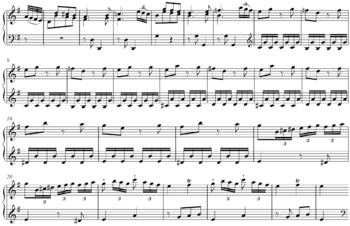Musical development
In classical music, musical development is a process by which a musical idea is communicated in the course of a composition. It refers to the transformation and restatement of initial material. Development is often contrasted with musical variation, which is a slightly different means to the same end. Development is carried out upon portions of material treated in many different presentations and combinations at a time, while variation depends upon one type of presentation at a time.[2]
In this process, certain central ideas are repeated in different contexts or in altered form so that the mind of the listener consciously or unconsciously compares the various incarnations of these ideas. Listeners may apprehend a "tension between expected and real results" (see irony), which is one "element of surprise" in music. This practice has its roots in counterpoint, where a theme or subject might create an impression of a pleasing or affective sort, but delight the mind further as its contrapuntal capabilities are gradually unveiled.
In sonata form, the middle section (between the exposition and the recapitulation) is called the development. Typically, in this section, material from the exposition section is developed. In some older texts, this section may be referred to as free fantasia.
According to the Oxford Companion to Music[3] there are several ways of developing a theme. These include:
- The division of a theme into parts, each of which can be developed in any of the above ways or recombined in a new way. Similarly, two or more themes can be developed in combination; in some cases, themes are composed with this possibility in mind.
- Alteration of pitch intervals while retaining the original rhythm.
- Rhythmic displacement, so that the metrical stress occurs at a different point in the otherwise unchanged theme.
- Sequence, either diatonically within a key or through a succession of keys.
The Scherzo movement from Beethoven's Piano Sonata No. 15 in D major, Op 28 (the "Pastoral" Sonata) shows a number of these processes at work on a small scale. Charles Rosen (2002) marvels at the simplicity of the musical material: "The opening theme consists of nothing but four F sharps in descending octaves, followed by a light and simple I/ii/V7/I cadence with a quirky motif repeated four times."[4] These opening eight bars provide all the material Beethoven needs to furnish his development, which takes place in bars 33-48:

Musical Development on a Larger Scale
Not all development takes place in what is commonly known as the "development section" of a work. It can take place at any point in the musical argument. For instance, the “immensely energetic sonata movement”[6] that forms the main body of the overture to Mozart’s Opera Don Giovanni announces the following theme during the initial exposition. It consists of two contrasting phrases: “first determined, then soft and conspiratorial.”[7]

William Mann says “the first, insistent phrase [of the above] is very important. At once it is taken up imitatively by various departments of the orchestra, and [starting in] A major, jumps through several related keys.”[8] Each repetition of the descending phrase is subtly altered one note at a time, causing the music to pass from the key of A major, through A minor and thence via a chord of G7 to the remote key of C major, and thence back to A major.

The central section of the Overture (the part commonly known as the "development section") utilizes both phrases of the theme “in new juxtapositions and new tonalities,” [9] developing it through repetition in a modulating sequence. The steady plod of the bass line against the sequential repetitions of the “soft and conspiratorial”[10] phrase outlines a circle of fifths chord progression:

Simultaneously, Mozart adds to the mix and continues to develop the imitative counterpoint that grew out of the first phrase. In the words of Willam Mann, this development “unites both halves”[11] of the theme. This is how this tightly woven texture pans out:

References
- Benward & Saker (2009), Music in Theory and Practice: Volume II, p.138-39. Eighth Edition. ISBN 978-0-07-310188-0.
- Wennerstrom, Mary (1975). "Form in Twentieth-Century Music" (chap. 1), Aspects of Twentieth-Century Music. Wittlich, Gary (ed.). Englewood Cliffs, New Jersey: Prentice-Hall. ISBN 0-13-049346-5.
- Temperley, N. (2002, p. 355) “Development” in Oxford Companion to Music. Oxford University Press.
- Rosen, C. (2002, p.161), Beethoven's Piano Sonatas, a Short Companion. Yale University Press.
- Rosen, C. (2002, p.162), Beethoven's Piano Sonatas, a Short Companion. Yale University Press.
- Mann, W. (1977, p. 462) the Operas of Mozart. London, Cassell.
- Mann, W. (1977, p. 462) the Operas of Mozart. London, Cassell.
- Mann, W. (1977, p. 462) the Operas of Mozart. London, Cassell.
- Taruskin, R. (2005, p.488) The Oxford History of Western Music, Volume 2 Music in the seventeenth and Eighteenth Centuries. Oxford University Press.
- Mann, W. (1977, p. 462) the Operas of Mozart. London, Cassell.
- Mann, W. (1977, p. 462) the Operas of Mozart. London, Cassell.
